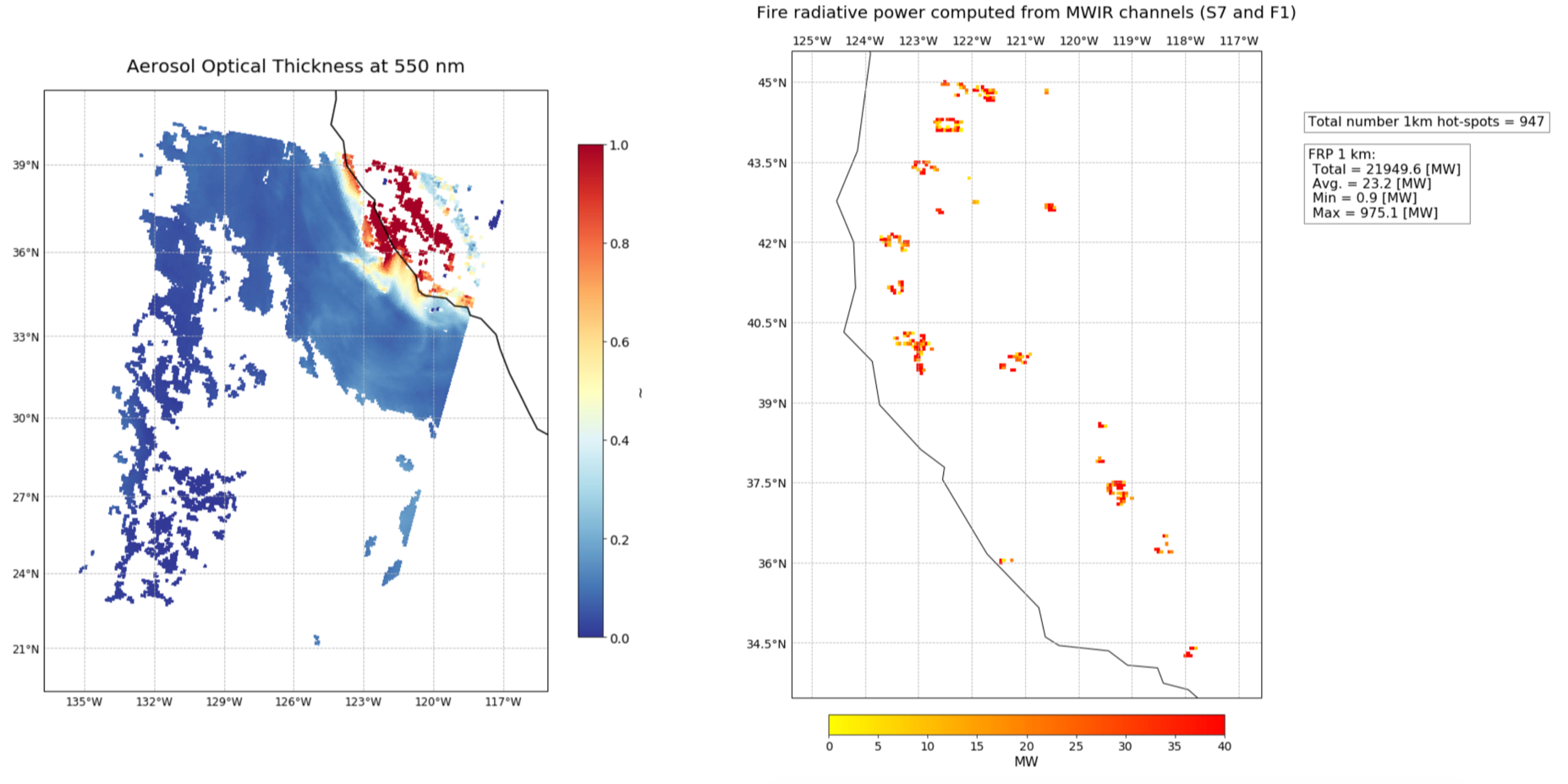Short_course_04: Summer(s) of fires: the 2020 wildfires in Australia, Siberia and California
Topic outline
-
This short course introduces you to fire monitoring with satellites in general and the NRT Sentinel-3 SLSTR Fire Radiative Power (FRP) and Aerosol Optical Depth (AOD) data products in specific. The course is accompanied with Jupyter-based training material that allows you to practically work with the data presented.
with Federico Fierli, Julien Chimot and Julia Wagemann
The short course consists of two parts:
- Short course | 14 Oct 2020, 12:00 UTC
- Short course feedback session | 19 Oct 2020, 12:00 UTC
The short course on 14 October gives you an introduction to the topic and the practical training material. Between the short course and the feedback session, you can work with the data in a self-paced manner. During the feedback session, we will discuss open questions and feedback.
You can engage and ask questions via Slido.com: #EUMSC4
Start familiarising yourself with the data and practical training material ahead of the short course.
See the section 'Jupyterhub and practical training material' on how to get access .

-
Recording
If you've missed the live session, please find the recording
.
-
The course has the following outline:
- 12:00 - 12:05: Welcome and Introduction (Federico Fierli, EUMETSAT)
- 12:05 - 12:50: Measuring fires and pollutants from Sentinel-3 (Julien Chimot, EUMETSAT)
- 12:50 - 13:15: NRT Sentinel-3 SLSTR Data Discovery with Jupyter notebooks (Julia Wagemann, MEEO)
- 13:15 - 13:30: Q&A and Wrap-Up (Federico Fierli, EUMETSAT)
To register for the course on 14 October please use this link:
https://eumetsat.zoom.us/meeting/register/tJUqcOutqD8qHtN4brOSWOPaUxjRgPyQe1w6
- Meeting ID: 917 7256 4047
- Passcode: 398602
-
The Copernicus Sentinel-3 (S3) NRT Fire Radiative Power (FRP) product detects and monitors the immediate threats of any 'burning' events over an area size of 1 km2. Commonly gathered under the term of hotspots, these are not only fires over continents, but also flames from persistent land and ocean gas flares, and active erupting volcanoes.
The Copernicus NRT S3 Aerosol Optical Depth (AOD) product quantifies the abundance of all aerosol particles suspended in the air and monitors their global distribution and long-range transport, at the scale of 9.5 x 9.5 km2. It is only applicable during daytime
All these observations are made available in less than three hours from the SLSTR observation sensing time.The EUMETSAT deployments are based on the NRT v2.0 processors. EUMETSAT is responsible for the generation and quality of all the Copernicus Sentinel-3 NRT atmospheric products, as well as its long-term validation and improvements, acting on behalf of the European Commission (EC). One of the key users of these products is the Copernicus Atmosphere Monitoring Service (CAMS), who is responsible for tracking the intensity and emissions of wildfires around the world.
Additional info on EUMETSAT S3 NRT website
How to access data ?
Sentinel3 are freely accessible at https://coda.eumetsat.int/#/home (registration required).
Choose Product Type", and select either SL_2_FRP___ (for Sentinel-3 SLSTR NRT FIre) or SL_2_AOD___ (for Sentinel-3 NRT Aerosol). After you defined the dates, a series of granules will be displayed over the world. And you can select the areas of your choice.
You can also visualize the current Sentinel-3 NRT Fire products on EUMETSAT S3 NRT website
-
The course material is made available on a JupyterHub instance, a pre-defined environment that gives learners direct access to the data and Python packages required for following the course.
The JupyterHub can be accessed as follows:
- Web address: https://ltpy.adamplatform.eu
- Create an account: https://wekeo-login.services.meeo.it
- Log into the JupyterHub with your account created.
There are 100 places available, which will be given on a first come first served basis.
------------------------------------------------------------------------------------------------------------------------
Alternatively, you can download the training material for the short course here:
In case you let it run on your local machine, you need the following technical specifications:
Python version: Python 3.6
Jupyter notebooks installed
Python packages:- xarray 0.14.1
- numpy 1.17.3
- matplotlib 3.1.2
- Cartopy 0.17.0
-
Our training activities support users in the member states and among the World Meteorological Organization (WMO) members in the application of EUMETSAT data, products, and services, including Copernicus data provided by EUMETSAT. Find our more at our web page.
Subscribe to the Training Bulletin the joint EUMETSAT, EUMETCAL, EUMeTrain newsletter on new activities and resources in European meteorological training — published every quarter.
Contact us for questions about training events and professional development opportunities at training@eumetsat.int.
Follow us on Twitter @eumetsat_users.